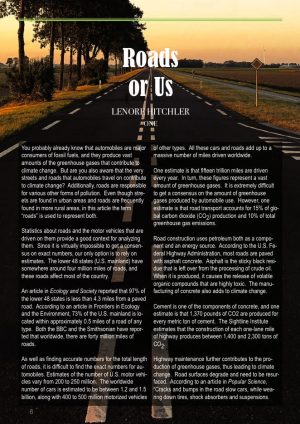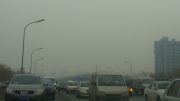 You probably already know that automobiles are major consumers of fossil fuels, and they produce vast amounts of the greenhouse gases that contribute to climate change. But are you also aware that the very streets and roads that automobiles travel on contribute to climate change? Additionally, roads are responsible for various other forms of pollution. Even though streets are found in urban areas and roads are frequently found in more rural areas, in this article the term “roads” is used to represent both.
You probably already know that automobiles are major consumers of fossil fuels, and they produce vast amounts of the greenhouse gases that contribute to climate change. But are you also aware that the very streets and roads that automobiles travel on contribute to climate change? Additionally, roads are responsible for various other forms of pollution. Even though streets are found in urban areas and roads are frequently found in more rural areas, in this article the term “roads” is used to represent both.
Statistics about roads and the motor vehicles that are driven on them provide a good context for analyzing them. Since it is virtually impossible to get a consensus on exact numbers, our only option is to rely on estimates. The lower 48 states (U.S. mainland) have somewhere around four million miles of roads, and these roads affect most of the country.
An article in Ecology and Society reported that 97% of the lower 48 states is less than 4.3 miles from a paved road. According to an article in Frontiers in Ecology and the Environment, 73% of the U.S. mainland is located within approximately 0.5 miles of a road of any type. Both the BBC and the Smithsonian have reported that worldwide, there are forty million miles of roads.
As well as finding accurate numbers for the total length of roads, it is difficult to find the exact numbers for automobiles. Estimates of the number of U.S. motor vehicles vary from 200 to 250 million. The worldwide number of cars is estimated to be between 1.2 and 1.5 billion, along with 400 to 500 million motorized vehicles of other types. All these cars and roads add up to a massive number of miles driven worldwide.
One estimate is that fifteen trillion miles are driven every year. In turn, these figures represent a vast amount of greenhouse gases. It is extremely difficult to get a consensus on the amount of greenhouse gases produced by automobile use. However, one estimate is that road transport accounts for 15% of global carbon dioxide (CO2) production and 10% of total greenhouse gas emissions.
Road construction uses petroleum both as a component and an energy source. According to the U.S. Federal Highway Administration, most roads are paved with asphalt concrete. Asphalt is the sticky black residue that is left over from the processing of crude oil. When it is produced, it causes the release of volatile organic compounds that are highly toxic. The manufacturing of concrete also adds to climate change.
Cement is one of the components of concrete, and one estimate is that 1,370 pounds of CO2 are produced for every metric ton of cement. The Sightline Institute estimates that the construction of each one-lane mile of highway produces between 1,400 and 2,300 tons of CO2.
Highway maintenance further contributes to the production of greenhouse gases, thus leading to climate change. Road surfaces degrade and need to be resurfaced. According to an article in Popular Science, “Cracks and bumps in the road slow cars, while wearing down tires, shock absorbers and suspensions. Drivers burn more gas and produce more carbon pollution to go the same distance.”
Vehicle tires also contribute to climate change since petroleum is one of the ingredients of tires, and oil has to be extracted and transported using fossil fuel energy.
Dr. Paul Donald in his book, Traffication, reported on the heavy toxic toll that tires place on the environment. Donald wrote that one and a half trillion ultrafine particulates are produced approximately every 0.62 miles due to tire wear. He also wrote that both particles from tire wear itself and road wear from tire friction are toxic pollutants and are possibly carcinogenic.
These particles contain toxic chemicals such as 2-mer-captobenzothiazole, which is used when vulcanizing rubber. Donald also wrote that globally, approximately six million tonnes of microplastics from tire wear on roads are produced each year.
He also reported that estimates vary from 10% to 60% of all microplastics in the oceans may originate in tires.
In fact, microplastic particles from Arctic sea ice match the same chemical structure as particles found in tires. Also, when discarded, decaying tires release even more toxic pollutants into the environment.
Besides writing about tires, Donald also wrote about pollution from road salt. To preserve tire traction on snowy and icy roads, a vast amount of road salt is applied. In the U.S., approximately twenty million tons of salt are used per year.
Worldwide, around sixty million tons are used every winter season. Donald reported that “Drinking water supplies can become contaminated by salt. Road salts can cause the release of highly toxic heavy metals such as mercury and lead from contaminated sediments.They can erode metal pipes carrying drinking water, releasing other poisons such as zinc.”
Donald added that “even in the height of summer, nearly 90% of waterbodies near roads have chloride levels that exceed federal guidelines.”
Science writer Ben Goldfarb wrote that due to road salt, “nearly half the lakes in the Midwest and Northeast are experiencing long-term salination.”
Too much salt in drinking water can contribute to poor health by increasing such risk factors as high blood pressure. Along with potentially damaging health, road salt can have corrosive effects on cars, trucks, bridges, and roads. The U.S. Environmental Protection Agency estimates that this damage costs approximately $5 billion annually in repairs.
The function of roads is to provide a space for automobiles to move from one place to another. In the process, many toxic substances are released into the atmosphere.
This pollution is quite pervasive throughout the globe. For instance, Donald pointed out that at least 70% of Britain, and perhaps over 90%, is contaminated by pollution from motor vehicles. Some of these toxic chemicals are the carcinogens benzene and formaldehyde.
Particulates from auto emissions can cause a wide variety of illnesses.
An incomplete listing of these includes cancer, cardiovascular and lung diseases, and neurological dysfunctions such as lower cognitive functioning and dementia. Donald stated that “particulate matter recovered from human brains is consistent in size and composition with that generated by road traffic.”
Donald reported on the harmful effects of air pollution on the human body. He wrote, “A review of the scientific evidence published up to 2019 found that particulate air pollution can reach, and can affect, virtually every cell in the body. As well as diseases associated with the respiratory and circulatory systems – asthma, bronchitis, lung cancer, stroke, heart disease, intravascular coagulation, heart attack, and a host of other killers – air pollution has been linked to depression and schizophrenia, all forms of dementia, pre-term birth, kidney disease, liver disease, leukemia, osteoporosis, conjunctivitis, inflammatory bowel disease, skin disease, and many other foul and life-eroding conditions.”
He also stated that children who are exposed to air pollution suffer from both physically and mentally reduced growth rates. Besides causing major illness, the pollution produced on roads increases mortality rates.
Donald reported that “At least four million people, and perhaps as many as nine million, die each year around the world from the effects of outdoor air pollution, with particulate matter being the biggest killer. One in eight deaths in the European Union is attributable to air pollution.”
Obviously, not all air pollution is caused by automobiles. However, transportation is responsible for a good amount of air pollution. Donald also reported that “In the United Kingdom, road traffic pollution is thought to account for over half of the 30,000 deaths caused each year by pollution, and tire wear particles alone may kill 8,000 people.”
Road traffic is also responsible for the spread of many major pests. An article in PLOS ONE provided a frightening look into the dangers of the many pests introduced into the environment. The article reviewed thirteen studies of various weed seeds and found 626 different species that were dispersed by cars.
Many alien species take over the native environment resulting in the loss of native species.
There are many ways that weed seeds can enter the environment from autos.
They can be found under the chassis, front and rear bumpers, wheel wells and rims, front and back mudguards, wheel arches, tires, and on interior floor mats. These many portals of entry ensure that it is virtually impossible to stop infestations of unwanted vegetation through highways and byways.
The article also estimated that “cars could be moving around from 490-980 million seeds in the United States, 248-496 million seeds in India, 240-480 million seeds in China, 25-450 million seeds in Australia, and 12-25 million seeds in South Africa.” Donald reported that a study in Berlin “estimated that up to 1,500 seeds are deposited on every square metre of road by vehicles every year.”
These statistics certainly represent potential massive ecological disasters. However, seeds dispersed by vehicles along roads are only dangerous if they grow into new plants. The book Road Ecology—Science and Solutions discussed the potential fertility of these seeds. For example, in Ibadan, Nigeria, forty different species of plants were grown from the mud collected from seventy-five vehicles. A study in Germany found 124 different plant species in the mud from a car driven around 9,300 miles on various roads.
In Canberra, Australia, seeds were collected from the wastewater of a car wash facility. Around 1,500 seedlings from more than 259 species germinated. Cane toads were disastrously introduced into Australia where they became pests.
The toads were able to move further into the country by moving along highways. Of course, some specific species benefit from roads.
However, as a general rule, roads upset the ecology of their surrounding area. Forests are at risk of destruction from introduced alien pests. Road Ecology—Science and Solutions reported on the spread of various pests across forested areas.
Spores of root decay fungi can be dispersed in soil attached to vehicles such as logging trucks. Motor vehicles have spread the range of gypsy moths which have defoliated large tracts of forests.
Human disease can also be spread along roads. Goldfarb reported that “In a 2022 article in the Lancet, the conservation biologist Gary Tabor and his colleagues described a concept they called ‘landscape immunity’ – the notion that fewer zoonotic diseases spill from intact, diverse ecosystems than from fragmented species-poor ones. And no force compromises immunity quite like a highway. If you want to prevent pandemics, you have to think about roads.” Goldfarb also reported that by the early 1970s, more than 10% of people living along the Trans-Amazonian road were infected with malaria.
Along with disease spread along roads, noise generated on roads is another pollutant that damages human health. More than 80% of the mainland U.S. is within 0.6 miles of a road. Additionally, approximately 80% of urban noise comes from motor vehicles.
The following long passage from Donald provides a good overall picture of how noise affects human health.
“The root of the problem is that we subconsciously perceive noise, even at fairly low levels, as a danger signal. Our bodies react involuntarily with a ‘fight or flight’ response, squirting stress hormones such as cortisol and adrenaline into our bloodstreams that trigger an increase in heart rate, blood pressure and anxiety. If this happens over prolonged periods, particularly at night when it disrupts vital sleep patterns, it can alter our body chemistry with devastating impacts on our health. People exposed to higher levels of road traffic noise are more likely to suffer from depression, bipolar disorder, anxiety, asthma, diabetes, stroke, coronary heart disease, chronic inflammation, brain damage and certain cancers. They drink more, smoke more and suffer higher rates of obesity than people living in less trafficked areas. Their children are more likely to be born prematurely and underweight, and as they grow up they are more likely to suffer from cognitive impairment, poor attention, slow development, behavioral problems and allergic conditions. A long-term study of thousands of female nurses in Denmark found that after other factors such as lifestyle and air pollution were accounted for, traffic noise pollution significantly reduced their life expectancy. Recent research indicates a worryingly strong association between road traffic noise and all forms of dementia, particularly Alzheimer’s disease.” Studies have also found an association between exposure to noise and both diabetes and breast cancer.
Roads and streets are a major contributor to climate change. Also, their construction and use produce vast amounts of pollution. Pollutants eventually end up in both soil and water leading to the further pollution of lakes, rivers, and oceans.
Fortunately, there are alternatives to our current transportation system. For example, households growing fruits and vegetables will cut down on pollution caused by transporting produce. Other alternatives involve buying fewer goods, and when purchasing essential products, buying them from local sources.
Most trips involve short distances, and both walking and riding bicycles are extremely healthy, inexpensive, and are good ecological alternatives to motor vehicles. One of the best alternatives is to increase the use of public transportation. Per passenger, they use much less oil and produce much less pollution.
To encourage new ridership, public transportation could be made quicker, more inexpensive, and more convenient. It will be extremely economically and politically difficult to remake the global transportation system. However, to fight climate change, the transportation system must lower its carbon footprint.
Lenore Hitchler




